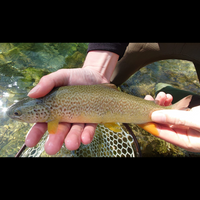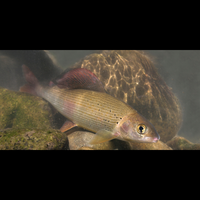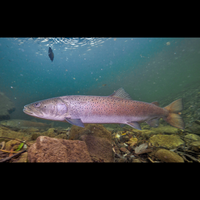Slovenia’s Native Salmonids: Species Profiles.
Slovenia is home to five native salmonid species, each with distinct range, habitat, and conservation stories. These species, central to the country’s trout heritage, include four featured in the Slovene Native Slam challenge (excluding Adriatic grayling because of recent hybridization). Below are the profiles:
Hucho Hucho.
- Range & Habitat: Native to large rivers of the Danube basin, including the Sava, Kolpa, and Drava. Requires deep, wide, cold rivers with abundant prey and clean spawning tributaries.
- Appearance & Size: The largest European salmonid. Long, torpedo-shaped body with a silvery base and subtle spots. Can exceed 120 cm and 15–20 kg.
- Behaviour: Apex predator. Feeds on fish, crustaceans, amphibians, and occasionally small mammals. Often holds in deep pools and channels.
- Life Cycle: Spawns in early spring (Mar–Apr) in clean gravel-bottom tributaries. Juveniles remain in shallower areas before migrating to deeper river sections.
- Conservation & Threats: Highly vulnerable due to its large range, late maturity, and low reproductive rate. Threatened by river regulation, barriers, and habitat loss. Populations are supported through regulated fishing, restocking, and protected zones.
Salmo Marmoratus.
- Range & Habitat: Native to the Adriatic basin, especially the Soča River and its tributaries (Idrijca, Bača, Trebuščica, Koritnica, Zadlascica). Prefers cold, clear, fast-flowing alpine rivers with rocky structure and deep pools.
- Appearance & Size: Known for its pale olive or grey base colour overlaid with irregular, worm-like marbled markings. Can exceed 120 cm and weigh over 20 kg, though most fish range between 40–70 cm.
- Behaviour: A solitary and highly territorial ambush predator. Juveniles feed on aquatic invertebrates; adults are piscivorous and often occupy deep pools or cover.
- Life Cycle: Spawning takes place in late autumn or early winter (Nov–Jan) in small, clean tributaries with gravel bottoms. Young fish hatch in early spring and disperse downstream.
- Conservation & Threats: Pure populations were nearly lost due to hybridization with stocked brown trout. A few isolated, genetically pure populations were rediscovered in the 1980s and have been the focus of ongoing conservation and restocking programs, especially by RD Tolmin. Threats include habitat loss, dams, hybridization, and climate change.
Salmo Trutta (Danubian).
- Range & Habitat: Native to the Danube basin, including rivers such as the Sava, Savinja, and Kamniška Bistrica. Found in fast-flowing mountain and foothill rivers with cool, oxygen-rich water.
- Appearance & Size: Golden-brown to olive in colour with red and black spots, often surrounded by pale halos. Commonly 35–50 cm; trophy fish can exceed 70–80 cm in large rivers.
- Behaviour: Opportunistic and adaptable. Feeds on insects, crustaceans, and small fish. Holds in riffles, undercut banks, and behind structure.
- Life Cycle: Spawns in late autumn (Oct–Dec) in clean, shallow gravel beds of tributaries. Eggs incubate over winter; fry emerge in early spring.
- Conservation & Threats: The native Danubian strain has declined due to stocking of non-native Atlantic strains. Current efforts aim to restore native genetics in wild populations through selective breeding and stocking.
Thymallus Thymallus.
- Range & Habitat: Widespread in the Danube basin. Found in the Sava Bohinjka, Savinja, Krka, and similar rivers with moderate to fast flow and gravel bottoms.
- Appearance & Size: Recognized by its large sail-like dorsal fin and delicate colouring. Typically 30–45 cm, with large individuals reaching 50 cm or more.
- Behaviour: Feeds primarily on aquatic insects and small crustaceans. Often active during hatches and visible rising in calmer riffles and runs.
- Life Cycle: Spawns in spring (Mar–May), earlier than trout. Uses shallow gravel beds in riffles with moderate current. Eggs hatch in late spring.
- Conservation & Threats: Generally stable in Slovenia but sensitive to pollution, water regulation, and sedimentation. Managed through seasonal closures and size restrictions.
Thymallus Aeliani.
- Range & Habitat: Historically native From the Po River basin to the Soča River basin. Preferred cold, fast-flowing alpine rivers with high oxygen content.
- Appearance & Size: Very similar to European grayling but less colourful and body proportions are a little different. Adults typically measured 25–40 cm, with occasional individuals reaching up to 45 cm.
- Behaviour: Insectivorous and surface-oriented feeder, especially during hatches. Favoured structured runs and moderate flow.
- Life Cycle: Spring spawner (Mar–May), using similar habitats as European grayling. No known surviving pure populations.
- Conservation & Threats: Extinct in its pure form due to hybridization with introduced Danubian grayling. All current grayling in the Soča basin are presumed hybrids. This species is excluded from the Native Slam




